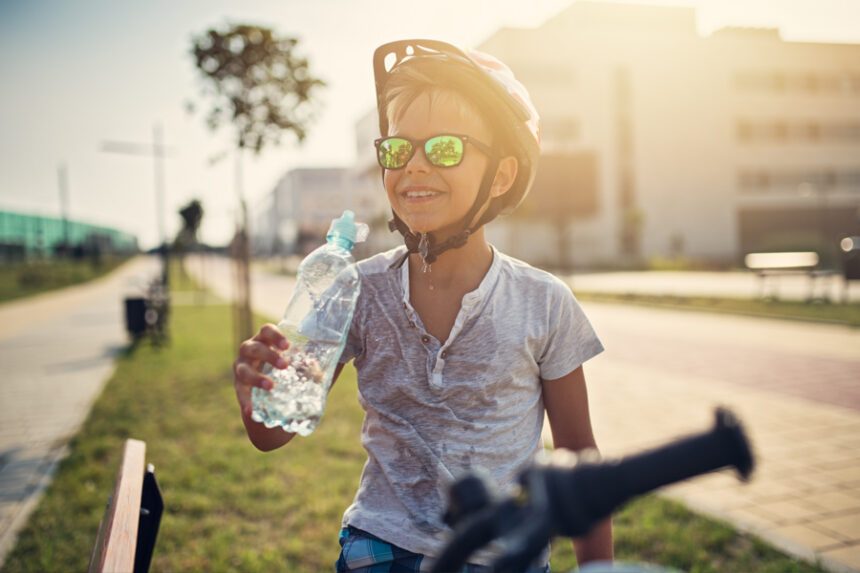When it comes to dealing with extreme heat and humidity, there are three rules to remember: Stay cool. Stay hydrated. Stay informed.
“A lot of heat-related illness can be prevented by doing these three things,” says UNC Health pediatric emergency department physician Daniel Park, MD.
Heat exhaustion and heatstroke are serious reactions our bodies can have when temperatures get too high. They both require immediate action—and heatstroke can be fatal.
Spotting Heat Exhaustion
When a person’s body overheats and can’t cool itself down, they may experience heat exhaustion, Dr. Park says. Their core body temperature can rise to between 99 and 104 degrees, and they may experience mild confusion, heavy sweating, paleness, muscle cramps, tiredness, weakness, dizziness, headache, nausea or vomiting, and fainting.
“If you see these symptoms, have the person stop all activity immediately,” he says. “Give them fluids—water or an electrolyte drink. Use a cool wet towel or cold packs for severe symptoms.”
If symptoms get worse or last longer than an hour, get medical attention. Left untreated, heat exhaustion can become heatstroke.
Signs of Heatstroke
Heatstroke is a medical emergency in which a person’s core body temperature exceeds 104 degrees, Dr. Park says. Their skin may be red, hot and dry—but no sweating. Their pulse may be rapid, and they might have a throbbing headache, dizziness or an upset stomach. They may also pass out or have hallucinations or seizures.
Call 911 immediately for help. Don’t try to get them to drink, because someone in an altered mental status could choke on anything you put in their mouth.
Stay Cool in the Heat
If the temperature and humidity are high, try to stay in an air-conditioned space, Dr. Park says. “If you don’t have air conditioning at home, go to a mall or public library.”
During high heat events, local health departments often provide a list of cooling centers or heat relief shelters, he says.
Beware of relying on electric fans, which aren’t powerful enough to lower your core body temperature. “Electric fans may provide comfort, but they won’t prevent heat-related illness when it’s really hot,” Dr. Park says.
To lower your body temperature, take a cool shower or bath.
If you do spend time outdoors, be mindful of your activities. Take frequent breaks and limit your activities to cooler times of day, such as morning or evening.
Stay Hydrated in the Heat
Drink plenty of water or electrolyte beverages (such as sports drinks—though watch the sugar content) throughout the day.
“Don’t wait until you’re thirsty,” Dr. Park says. “By then, you’re already dehydrated.”
Avoid very sugary or alcoholic drinks, which cause you to lose more body fluid. Very cold drinks may cause stomach cramps when you are hot.
Make sure children and pets have lots of water to drink, too.
Wearing sunscreen (SPF 15 or higher), a wide-brimmed hat and sunglasses can help protect your skin from sunburn. Sunburn reduces your body’s ability to cool itself down and can make you dehydrated.
Stay Informed to Beat the Heat
Pay attention to your local weather forecast. You’ll want to look at the temperature, humidity and heat index—what the temperature feels like to the human body. It’s often higher than the temperature alone.
Everyone’s body reacts differently to heat, but the National Weather Service heat index recommends caution once the temperature hits 80 and humidity is 40 percent or higher. Temperatures in the 90s with at least 70 percent humidity, for example, would qualify as dangerous.
“Find out if your area is anticipating a high heat index,” Dr. Park says. “If so, be mindful of the kinds of activities you’re planning.”
Never Leave a Person or Animal in a Car
Even if a car’s windows are cracked or open, temperatures inside can soar in minutes and result in death.
“You might think you’d never forget your child is in the back seat, but it happens,” Dr. Park says. On average, 38 children under age 15 die of heatstroke after being left in a car each year in the United States. “It’s not a matter of how much you love your child. We get distracted. It’s human nature.”
Dr. Park recommends visual reminders. “Keep a stuffed animal in the car,” he says. “Put it up front where the driver can see it when the child is in the car.”
Some drivers put their left shoe in the back seat, because you wouldn’t walk out of the car without a shoe. Make it a habit to always check your back seat.
Elderly passengers are also at greater risk in the heat. They may be harder to forget, but don’t leave them—or anyone, including pets—in a car, even for a few minutes. The temperature inside a car gets much hotter than the outside temperature very quickly.
Know Who Is at High Risk for Heat Illnesses
Some people are at greater risk than others for heat-related illnesses, Dr. Park says. These include infants and young children, people age 65 and older, people who are overweight and those who overexert during work or exercise. People with chronic conditions including heart disease, high blood pressure, asthma and chronic obstructive pulmonary disease are also at higher risk, as are people taking certain medications.
“Everyone’s threshold for heat illness is different,” Dr. Park says. “We think of children, the elderly and people with chronic health conditions as being at the greatest risk, and we should keep an eye on them. But preventive measures are the same for everyone. Heat-related illness is easier to prevent than it is to manage.”
Talk to your doctor about preventing heat-related illnesses for yourself and your family. Need a doctor? Find a doctor near you.

